| Listing 1 - 10 of 15 | << page >> |
Sort by
|
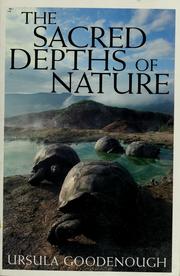
ISBN: 1280530324 9786610530328 0198029152 1429414693 9781429414692 9781280530326 9780195126136 0195126130 0195136292 9780195136296 6610530327 9780198029151 0199839441 0197701930 9780199839445 Year: 1998 Publisher: New York : Oxford University Press,
Abstract | Keywords | Export | Availability | Bookmark
 Loading...
Loading...Choose an application
- Reference Manager
- EndNote
- RefWorks (Direct export to RefWorks)
Covering such topics as evolution, emotions, sexuality, and death, this volume reconciles the modern scientific understanding of reality with our spiritual yearnings for reverence and continuity.
Biology --- Naturalism --- Nature --- Philosophy of nature --- Religion and science --- Vitalism --- Philosophy. --- Religious aspects. --- Religious interpretations
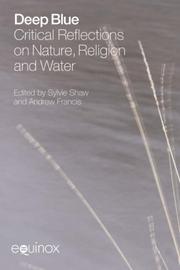
ISBN: 1138465151 1315710188 1317488180 184553719X 9781845537197 9781317488187 9781845532550 1845532554 9781138465152 9781315710181 9781317488163 9781317488170 1317488172 Year: 2008 Publisher: London ; Oakville, CT : Equinox Pub.,
Abstract | Keywords | Export | Availability | Bookmark
 Loading...
Loading...Choose an application
- Reference Manager
- EndNote
- RefWorks (Direct export to RefWorks)
Nature religions look to rivers, lakes and oceans for inspiration and spiritual transformation. Deep Blue brings together the work of influential scholars in the field of nature religion, ranging across anthropology, mythology, sociology and psychology. The essays examine the interrelationship between spiritual practice, critical thinking, and environmental concern. Tracing the ancient history of humanity's close relationship with both salt and fresh water, the book calls for a sustainable relationship with water in contemporary western culture. Deep Blue will be of interest to students of paganism and religion, environmental researchers and activists, and all those involved in the intersection between religion and ecology.
Nature --- Philosophy of nature --- Religion and science --- Religious aspects. --- Religious interpretations
Book
ISBN: 9781438477930 1438477937 9781438477947 1438477945 1438477953 Year: 2020 Publisher: Albany, New York : SUNY Press,
Abstract | Keywords | Export | Availability | Bookmark
 Loading...
Loading...Choose an application
- Reference Manager
- EndNote
- RefWorks (Direct export to RefWorks)
"In Living Landscapes , Christopher Key Chapple looks at the world of ritual as enacted in three faiths of India. He begins with an exploration of the relationship between the body and the world as found in the cosmological cartography of Sāṃkhya philosophy, which highlights the interplay between consciousness ( puruṣa ) and activity ( prakṛti ), a process that gives rise to earth, water, fire, air, and space. He then turns to the progressive explication of these five great elements in Buddhism, Jainism, Advaita, Tantra, and Haṭha Yoga, and includes translations from the Vedas and the Purāṇas of Hinduism, the Buddhist and Jain Sūtras, and select animal fables from early Hinduism, Buddhism, and Jainism. Chapple also describes his own pilgrimages to the Great Stupa at Shambhala Mountain Center in Colorado, the five elemental temples ( pañcamahābhūta mandir ) in south India, and the Jaina cosmology complex in Hastinapur. An appendix with practical instructions that integrate Yoga postures with meditative reflections on the five elements is included"--
Yoga. --- Nature --- Religious aspects. --- India --- Religion. --- Nature - Religious aspects. --- India - Religion. --- Philosophy of nature --- Religion and science --- Yoga --- Yoga exercises --- Exercise --- Philosophy, Indic --- Religious interpretations --- Hinduism
Book
ISBN: 0791477932 1435666895 9781435666894 0791475190 9780791475195 9780791477939 9780791475201 Year: 2008 Publisher: Albany : State University of New York Press,
Abstract | Keywords | Export | Availability | Bookmark
 Loading...
Loading...Choose an application
- Reference Manager
- EndNote
- RefWorks (Direct export to RefWorks)
In this book Donald A. Crosby looks at how a religion based on the sacredness of nature deals with the problem of evil. Further developing and defending the vision of religious thought and life elaborated in his previous work, A Religion of Nature, Crosby explores how such a vision can enable us to interpret, respond to, and cope with the diverse forms of evil in the world, arguing that an ambiguity of goods and evils in human life, in nature as a whole, and in any conceivable or desirable realm of existence is inevitable. It is therefore futile to seek recourse in powers, presences, states, or realms thought to wholly transcend a combination of goods and evils or to be entirely devoid of evil. This being the case, the central problem of an adequate religious faith is how to live a constructive, meaningful life in the face of this intractable ambiguity. Religion of nature, as it is laid out and explained here, confronts this problem and offers a comprehensive, sustaining, and fully adequate way of conceiving and living a religious life.
Nature --- Naturalism --- Philosophy of nature --- Religion and science --- Religious aspects. --- Religious interpretations --- 113/119 --- 21 --- 113/119 Kosmologie. Natuurfilosofie. Filosofie van de natuur --- Kosmologie. Natuurfilosofie. Filosofie van de natuur --- Religious aspects --- Theodicee. Natuurlijke godsleer. Natuurlijke theologie
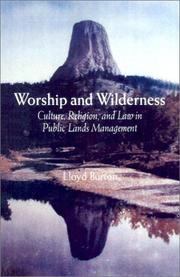
ISBN: 1282788248 9786612788246 0299180832 9780299180836 0299180808 0299180840 9780299180805 9780299180843 9781282788244 6612788240 Year: 2002 Publisher: Madison University of Wisconsin Press
Abstract | Keywords | Export | Availability | Bookmark
 Loading...
Loading...Choose an application
- Reference Manager
- EndNote
- RefWorks (Direct export to RefWorks)
Public lands --- Nature --- Lands, Public --- Land use --- Public domain --- Crown lands --- Natural resources, Communal --- Philosophy of nature --- Religion and science --- Management. --- Religious aspects. --- Law and legislation --- Religious interpretations --- Nature - Religious aspects. --- Public lands - Management.
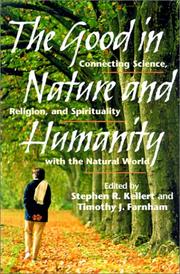
ISBN: 1610910761 1559638389 9781559638388 1423707893 9781423707899 9781610910767 Year: 2002 Publisher: Washington, DC Island Press
Abstract | Keywords | Export | Availability | Bookmark
 Loading...
Loading...Choose an application
- Reference Manager
- EndNote
- RefWorks (Direct export to RefWorks)
Religion and science. --- Nature --- Human ecology --- Ecotheology --- Philosophy of nature --- Religion and science --- Christianity and science --- Geology --- Geology and religion --- Science --- Science and religion --- Religious aspects. --- Religious interpretations --- Religious aspects
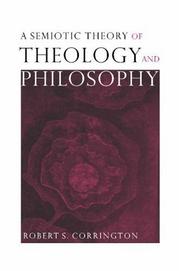
ISBN: 1107120780 0511009704 1280432624 0511172567 051115139X 0511310595 0511487649 0511046316 9780511009709 0511031068 9780511031069 9780511487644 0521782716 9780521782715 9780521782715 0521782716 9780521093248 0521093244 Year: 2000 Publisher: Cambridge New York, NY Cambridge University Press
Abstract | Keywords | Export | Availability | Bookmark
 Loading...
Loading...Choose an application
- Reference Manager
- EndNote
- RefWorks (Direct export to RefWorks)
The concern of this work is with developing an alternative to standard categories in theology and philosophy, especially in terms of how they deal with nature. Avoiding the polemics of much contemporary reflection on nature, it shows how we are connected to nature through the unconscious and its unique way of reading and processing signs. Spinoza's key distinction between natura naturans and natura naturata serves as the governing framework for the treatise. Suggestions are made for a post-Christian way of understanding religion. Robert S. Corrington's work represents the first sustained attempt to bring together the fields of semiotics, depth-psychology, pragmaticism, and a post-Monotheistic theology of nature. Its focus is on how signification functions in human and non-human orders of infinite nature. Our connection with the infinite is described in detail, especially as it relates to the use of sign systems.
Philosophy of nature. --- Semiotics. --- Nature --- Semiotics --- Philosophical theology. --- Theology, Philosophical --- Philosophy and religion --- Theology, Doctrinal --- Philosophy of nature --- Religion and science --- Semeiotics --- Semiology (Linguistics) --- Semantics --- Signs and symbols --- Structuralism (Literary analysis) --- Nature, Philosophy of --- Natural theology --- Religious aspects. --- Religious interpretations --- Philosophy --- Philosophical theology --- Religious aspects --- Arts and Humanities --- Religion
Book
ISBN: 1479865265 9781479865260 1479886416 9781479886418 9781479886418 9781479873012 1479873012 Year: 2016 Publisher: New York, NY
Abstract | Keywords | Export | Availability | Bookmark
 Loading...
Loading...Choose an application
- Reference Manager
- EndNote
- RefWorks (Direct export to RefWorks)
An exploration of the production and reception of nature and spirituality in America’s national park system America’s national parks are some of the most powerful, beautiful, and inspiring spots on the earth. They are often considered “spiritual” places in which one can connect to oneself and to nature. But it takes a lot of work to make nature appear natural. To maintain the apparently pristine landscapes of our parks, the National Park Service must engage in traffic management, landscape design, crowd-diffusing techniques, viewpoint construction, behavioral management, and more—and to preserve the “spiritual” experience of the park, they have to keep this labor invisible. Spirituality and the State analyzes the way that the state manages spirituality in the parks through subtle, sophisticated, unspoken, and powerful techniques. Following the demands of a secular ethos, park officials have developed strategies that slide under the church/state barrier to facilitate deep connections between visitors and the space, connections that visitors often express as spiritual. Through indirect communication, the design of trails, roads, and vista points, and the management of land, bodies and sense perception, the state invests visitors in a certain way of experiencing reality that is perceived as natural, individual, and authentic. This construction of experience naturalizes the exercise of authority and the historical, social, and political interests that lie behind it. In this way a personal, individual, nature spirituality becomes a public religion of a particularly liberal stripe. Drawing on surveys and interviews with visitors and rangers as well as analyses of park spaces, Spirituality and the State investigates the production and reception of nature and spirituality in America’s national park system.
National parks and reserves --- Nature --- Pilgrims and pilgrimages --- Religion and state --- Sacred space --- RELIGION / Religion, Politics & State. --- Holy places --- Places, Sacred --- Sacred places --- Sacred sites --- Sacred spaces --- Sites, Sacred --- Space, Sacred --- Holy, The --- Religion and geography --- Pilgrimages and pilgrims --- Processions, Religious --- Travelers --- Voyages and travels --- Shrines --- Philosophy of nature --- Religion and science --- Religious aspects. --- Religious interpretations --- Spiritual tourism
Book
ISBN: 1496212916 9781496212917 9781496207883 1496207882 9781496212894 9781496212900 1496212894 Year: 2019 Publisher: Lincoln
Abstract | Keywords | Export | Availability | Bookmark
 Loading...
Loading...Choose an application
- Reference Manager
- EndNote
- RefWorks (Direct export to RefWorks)
"Sacred Seeds examines New World plants and their associated Native myths as they moved across the Atlantic and into English literature"-- "More than five hundred years after the fact, present-day writers still use hyperbolic adjectives to describe the "discovery" of the Americas. Columbus's crossing of the Atlantic--and the age of exploration that ensued--dramatically and forever changed the early modern world. The societies, economies, cultures, arts, and burgeoning sciences of Europe were quickly transformed by the ongoing encounter with the New World. The meeting of the New and the Old Worlds, however, was more than a meeting of disparate civilizations. It was also a confluence of exciting and often surprising associations that continually created new interfaces between materials and knowledge. The Western and Eastern Hemispheres, brought together by sailing ships for the first time on a large scale, helped create the global landscape we take for granted today. Central to this formative moment in global history were New World plants. The agriculture of indigenous peoples mythically and materially shaped English society and, subsequently, its literature in new and startling ways. Sacred Seeds examines New World plants--tobacco, amaranth, guaiacum, and the prickly pear cactus--and their associated Native myths as they moved across the Atlantic and into English literature. Edward McLean Test reinstates the contributions of indigenous peoples to European society, charting an alternative cultural history that explores the associations and assemblages of transatlantic multiplicity rather than Eurocentric homogeny"--
LITERARY CRITICISM / European / English, Irish, Scottish, Welsh. --- LITERARY CRITICISM / Renaissance. --- Nature --- Indigenous peoples --- America in literature. --- Plants in literature. --- Gardens in literature. --- English literature --- Philosophy of nature --- Religion and science --- Aboriginal peoples --- Aborigines --- Adivasis --- Indigenous populations --- Native peoples --- Native races --- Ethnology --- Religious aspects. --- Influence. --- History and criticism. --- Religious interpretations --- Europe --- United States --- Civilization --- American influences.
Periodical
Abstract | Keywords | Export | Availability | Bookmark
 Loading...
Loading...Choose an application
- Reference Manager
- EndNote
- RefWorks (Direct export to RefWorks)
Nature --- Human ecology --- Religions --- Religious aspects --- Écologie humaine --- Aspect religieux. --- Religious aspects. --- Ecology --- Environment, Human --- Human beings --- Human environment --- Social aspects --- Religious interpretations --- Ecological engineering --- Human geography --- Ecotheology --- Philosophy of nature --- Religion and science --- Effect of environment on --- Effect of human beings on --- Arts and Humanities --- Environmental Sciences --- Philosophy --- Religion --- Society and Culture --- Environmental Planning & Studies --- Religions. --- Comparative religion --- Denominations, Religious --- Religion, Comparative --- Religions, Comparative --- Religious denominations --- World religions --- Civilization --- Gods --- Aspect religieux
| Listing 1 - 10 of 15 | << page >> |
Sort by
|

 Search
Search Feedback
Feedback About UniCat
About UniCat  Help
Help News
News